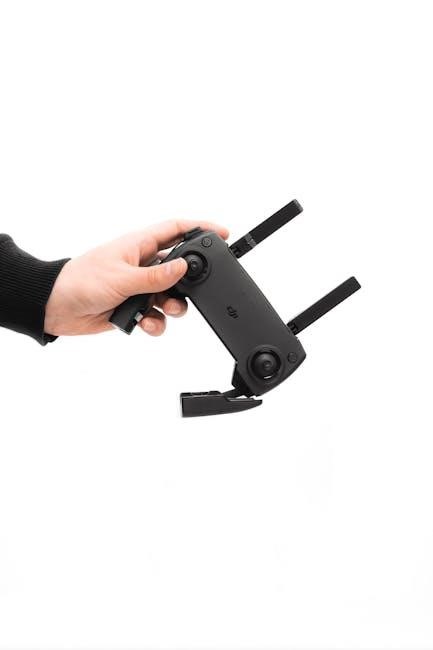
The Dixell XR60CX is a digital controller designed for refrigeration systems, offering advanced features like defrost management, fan control, and temperature monitoring․ The user manual is essential for proper setup, operation, and troubleshooting, ensuring optimal performance and efficiency in various applications․
1․1 Overview of the Controller and Its Features
The Dixell XR60CX is a sophisticated digital controller designed for precise temperature management in refrigeration systems․ It offers advanced features such as defrost management, fan control, and temperature monitoring․ The controller supports multiple fan operating modes, including running with the compressor, continuous operation, or during defrost cycles․ Additionally, it provides options for forced fan activation to prevent short cycling and cyclical fan control for energy efficiency․ The XR60CX also includes a user-friendly interface for easy parameter adjustment and a robust alarm system for notifications․ Its compact design and compatibility with various refrigeration units make it a versatile solution for commercial and industrial applications․ The controller’s functionality is further enhanced by remote monitoring capabilities, ensuring optimal performance and reliability․
1․2 Importance of the User Manual for Effective Operation
The Dixell XR60CX user manual is essential for understanding and operating the controller effectively․ It provides comprehensive information about the controller’s features, installation, and operation, ensuring users can maximize its capabilities․ The manual includes detailed instructions for setup, configuration, and troubleshooting, which are critical for avoiding errors and ensuring optimal performance․ Without the manual, users may struggle to fully utilize the controller’s advanced functions, such as defrost management and fan control․ It also outlines safety guidelines and best practices to prevent damage to the system or the controller itself․ By following the manual, users can avoid common mistakes, such as incorrect parameter settings or improper connections․ Ultimately, the manual serves as a vital resource for achieving efficient and reliable operation of the XR60CX controller in various applications․

Installation and Setup

Proper installation and setup are crucial for the Dixell XR60CX controller’s functionality․ Follow the manual for correct wiring, mounting, and configuration steps to ensure smooth operation․
2․1 Pre-Installation Checks
Before installing the Dixell XR60CX controller, perform essential pre-installation checks to ensure compatibility and safety․ Verify the controller model matches your equipment requirements․ Inspect the packaging for damage and ensure all components, including wiring and mounting hardware, are included․ Check the operating voltage matches your power supply․ Ensure the installation environment meets temperature and humidity specifications․ Review the user manual for specific recommendations․ Verify compatibility with existing systems and sensors․ Perform a power supply check to avoid electrical issues․ Finally, confirm the controller’s firmware is up-to-date for optimal performance․ Addressing these checks ensures a smooth and safe installation process․
2․2 Step-by-Step Installation Process

Begin by carefully unpacking the Dixell XR60CX controller and preparing the installation site․ Locate a suitable mounting position, ensuring it is level, secure, and accessible․ Mount the controller using the provided hardware, following the manual’s guidelines․ Connect the wiring according to the diagram, ensuring all terminals are securely attached․ Power up the controller and perform a quick system check to verify basic functionality․ Configure initial settings, such as temperature ranges and defrost modes, to match your specific requirements․ Test all inputs and outputs to ensure proper operation․ Finally, review the installation to confirm compliance with safety standards and manufacturer recommendations․ This systematic approach ensures a reliable and efficient setup of the Dixell XR60CX controller․
2․3 Wiring and Connections
The Dixell XR60CX controller requires precise wiring to ensure proper functionality․ Begin by referring to the wiring diagram provided in the user manual to identify the correct terminals for power supply, sensors, and output devices․ Connect the power supply wires to the designated terminals, ensuring they are securely fastened․ Next, attach the sensor wires, matching the positive and negative terminals accurately․ For output devices such as fans or defrost elements, connect them to the appropriate relay or output terminals․ Use the correct gauge of wire and avoid overloading circuits․ Secure all connections tightly to prevent loosening over time․ After completing the wiring, power up the controller and test each connection to ensure proper operation․ Double-check all connections for accuracy and safety before proceeding with further setup․
2․4 Mounting the Controller
Mounting the Dixell XR60CX controller requires careful planning to ensure optimal performance and durability․ Choose a location that is dry, well-ventilated, and protected from direct sunlight or moisture․ Avoid areas near heating vents or extreme temperature sources․ Use the mounting holes on the back panel of the controller to secure it to a flat surface․ Ensure the controller is level and firmly fastened using appropriate screws․ Do not overtighten, as this may damage the housing․ After mounting, double-check that all connections remain accessible and secure․ Ensure the controller is properly grounded to prevent electrical interference․ Once mounted, proceed to connect the wiring and sensors as outlined in the wiring diagram․ Proper mounting ensures reliable operation and extends the lifespan of the controller․
2․5 Initial Setup and Configuration
After installation, power on the Dixell XR60CX controller and allow it to initialize․ Check the display for any error messages or prompts․ Use the navigation buttons to access the main menu and select the setup option․ Set the basic parameters such as temperature units, time format, and language․ Configure the defrost mode, fan settings, and alarm thresholds according to your specific requirements․ Ensure all sensors are correctly connected and calibrated․ Review and save the configuration to apply the settings․ Test the controller by running a diagnostic cycle to verify proper operation․ Refer to the wiring diagram to confirm all connections are correct․ If prompted, enter a password to secure the settings․ Once configured, the controller is ready for normal operation․ Proper initial setup ensures accurate performance and minimizes the risk of operational issues․ Always refer to the user manual for detailed configuration guidelines․

Operating Instructions
Understanding the control panel layout is essential for navigating the menu, setting parameters, activating manual defrost, and managing fan control modes efficiently for optimal performance․
3․1 Understanding the Control Panel Layout
The Dixell XR60CX controller features an intuitive control panel designed for easy operation․ The panel includes a clear display screen showing real-time data, such as temperature, system status, and active settings․ Below the display, a series of buttons are labeled for specific functions, including navigation, parameter adjustment, and mode selection․ The layout is organized to ensure quick access to essential controls, with commonly used functions placed prominently․ Status indicators, such as LEDs, provide visual feedback on system operation, alarms, and active modes․ Understanding the control panel layout is crucial for efficient operation, as it allows users to monitor, adjust, and control the system seamlessly․ Familiarizing yourself with the buttons, display, and indicators ensures smooth interaction with the controller․
3․2 Navigating the Menu and Basic Operations
Navigating the Dixell XR60CX menu is straightforward, with a logical structure designed for ease of use․ The controller features a menu-driven interface accessible via the control panel buttons․ Basic operations include scrolling through menu options using navigation keys, selecting items with a confirmation button, and adjusting parameters using increment/decrement buttons․ The home screen displays essential information, while deeper menu levels provide access to advanced settings․ Users can easily return to the home screen or exit a submenu using designated buttons․ The menu is divided into categories, such as configuration, monitoring, and maintenance, ensuring quick access to desired functions․ Familiarizing yourself with the navigation flow allows for efficient operation and quick adjustments․ Regular users will find the menu intuitive, enabling seamless control of the system․
3․3 Setting and Adjusting Parameters
Setting and adjusting parameters on the Dixell XR60CX controller is a straightforward process that allows users to customize its operation to meet specific needs․ Parameters are accessed through the menu system, where users can select and modify values such as temperature setpoints, defrost intervals, fan speeds, and alarm levels․ The controller uses arrow keys for navigation, with the “Enter” button to select a parameter and the “+” or “-” buttons to adjust its value․ Once changes are made, they are automatically saved, ensuring the system operates with the updated settings․ Regularly reviewing and adjusting parameters can optimize performance, energy efficiency, and system reliability․ Always refer to the user manual for a list of available parameters and their recommended ranges to avoid incorrect configurations․
3․4 Activating Manual Defrost
Activating manual defrost on the Dixell XR60CX controller allows users to initiate a defrost cycle outside of the scheduled defrost program․ This feature is useful for maintaining system efficiency and preventing excessive ice buildup․ To activate manual defrost, navigate to the defrost menu using the arrow keys․ Select the “Manual Defrost” option and press “Enter” to confirm․ The controller will then activate the defrost cycle, stopping the compressor and starting the defrost process․ Once the cycle is complete, the controller will automatically resume normal operation․ Manual defrost should only be used when necessary to avoid unnecessary interruptions to the system’s operation․ Always ensure the system is in a stable state before initiating manual defrost to maintain optimal performance and prevent potential issues․
3․5 Fan Control Modes and Settings
The Dixell XR60CX controller offers multiple fan control modes to optimize system performance and energy efficiency․ Users can select from fixed speed, variable speed, or smart modes, depending on the application requirements․ Fixed speed mode operates the fan at a constant RPM, while variable speed mode adjusts based on temperature or other parameters․ Smart mode uses advanced algorithms to minimize energy consumption while maintaining optimal conditions․ Adjustments can be made via the control panel by navigating to the fan settings menu․ Options include setting minimum and maximum fan speeds, enabling or disabling adaptive control, and configuring alarms for fan failure or abnormal operation․ Proper configuration of fan settings ensures reliable operation, reduces energy costs, and extends equipment lifespan․ Regularly reviewing and adjusting fan settings helps maintain optimal system performance in changing environmental conditions․

Advanced Features and Functions
The Dixell XR60CX offers advanced features like smart defrost, energy-saving modes, and real-time monitoring, ensuring efficient and adaptable temperature control for various applications․
4․1 Defrost Modes and Schedules
The Dixell XR60CX controller offers multiple defrost modes, including time-based, temperature-based, and adaptive defrost, allowing users to customize defrosting according to specific requirements․ The scheduler enables setting defrost cycles at optimal times, ensuring efficiency and preventing unnecessary energy consumption․ Adaptive defrost mode automatically adjusts the frequency based on system performance and environmental conditions․ Users can configure defrost duration, start times, and intervals through the control panel or remote interface․ This feature ensures consistent operational efficiency, prevents ice buildup, and maintains optimal temperature control․ Regular defrosting also reduces wear and tear on the system, extending its lifespan․ The manual provides detailed steps to program and monitor defrost schedules, ensuring seamless integration into daily operations․
4․2 Fan Management and Energy Efficiency
The Dixell XR60CX controller offers advanced fan management features to optimize energy consumption while maintaining precise temperature control․ Users can select from multiple fan modes, including fixed speed, variable speed, and smart mode, which adjusts fan operation based on system demands․ The controller also supports energy-saving functions, such as adaptive fan speed adjustment, reducing power usage during low-load conditions․ Additionally, the system incorporates intelligent algorithms to minimize energy waste by synchronizing fan operation with defrost cycles and temperature setpoints․ These features not only enhance energy efficiency but also prolong the lifespan of the fan and compressor by reducing unnecessary operation․ The user manual provides detailed guidance on configuring fan settings and optimizing energy-saving parameters to achieve maximum performance while minimizing operational costs․
4․3 Temperature Control and Monitoring
The Dixell XR60CX controller provides precise temperature control and monitoring capabilities, ensuring optimal performance in various applications․ It supports a wide temperature range, from -40°C to 120°C, and offers high accuracy with programmable setpoints and hysteresis․ The controller features advanced temperature monitoring through NTC probes or other compatible sensors, providing real-time data on the LCD display․ Users can configure temperature alerts and alarms to maintain desired conditions and prevent deviations․ The system also allows for remote monitoring via optional communication modules, enabling users to track temperature data from a centralized location․ The user manual details how to set up and fine-tune temperature parameters, ensuring accurate and reliable operation․ This feature is essential for maintaining product quality, reducing energy consumption, and extending equipment lifespan in commercial refrigeration and HVAC systems․
4․4 Alarm Systems and Notifications
The Dixell XR60CX controller is equipped with a comprehensive alarm system designed to notify users of critical system conditions․ It supports customizable alarms for temperature deviations, fan malfunctions, and system errors, ensuring timely intervention․ The controller triggers visual alerts on its LCD display and audible notifications through a built-in buzzer․ Users can set high and low alarm limits for temperature, compressor, and fan operations, providing flexibility for various applications․ Additionally, the system can send notifications via optional communication modules, such as SMS or email, for remote monitoring․ The user manual details how to configure alarms, customize notifications, and integrate them with external systems․ This feature enhances system reliability, reduces downtime, and ensures continuous operation by alerting users to potential issues before they escalate․
4․5 Remote Monitoring and Control
The Dixell XR60CX controller offers advanced remote monitoring and control capabilities, enabling users to manage their system efficiently from a distance․ By integrating with compatible communication modules, such as Ethernet or Wi-Fi adapters, the controller can connect to external devices like computers, tablets, or smartphones․ This allows real-time monitoring of temperature, fan status, and other critical parameters․ Users can also adjust settings, activate defrost modes, and receive notifications remotely․ The controller supports software tools provided by Dixell, enabling seamless integration with building management systems (BMS) or cloud platforms․ Remote access enhances operational flexibility, reduces on-site visits, and ensures prompt responses to system changes or alarms․ The user manual provides detailed instructions for setting up and configuring remote monitoring and control features, ensuring optimal performance and convenience․

Troubleshooting and Maintenance
Troubleshooting and maintenance are essential for ensuring the Dixell XR60CX controller operates efficiently․ This section provides solutions for common issues, error code interpretations, and routine maintenance tasks to prevent malfunctions and extend lifespan․
5․1 Common Issues and Solutions
Identifying and resolving common issues with the Dixell XR60CX controller is crucial for uninterrupted operation․ One frequent issue is incorrect temperature readings, often caused by faulty sensors or loose connections․ Ensure sensors are clean and properly secured․ Another common problem is communication errors, which can be resolved by checking wiring connections and ensuring compatibility with external devices․ If the controller fails to start, verify power supply and check for blown fuses or tripped circuit breakers․ For display malfunctions, restart the controller or update firmware if necessary․ Addressing alarms promptly is vital; refer to error codes for specific solutions․ Regularly cleaning the controller and ensuring proper ventilation can prevent overheating issues․ Always consult the user manual or contact support for persistent problems․ Timely troubleshooting ensures optimal performance and extends the controller’s lifespan․ Proper maintenance and quick issue resolution are key to reliable operation․
5․2 Error Codes and Their Meanings
The Dixell XR60CX controller uses specific error codes to indicate malfunctions, helping users identify and address issues efficiently․ Common error codes include E1 (temperature sensor fault), E2 (communication error), and E3 (relay or output failure)․ These codes are displayed on the control panel to alert users of potential problems․ Understanding their meanings is crucial for quick troubleshooting․ For example, E1 may indicate a disconnected or faulty temperature sensor, while E2 suggests issues with RS485 communication․ The user manual provides a comprehensive list of error codes and their corresponding explanations․ Referencing the manual ensures accurate diagnostics and helps users take corrective actions, such as checking connections or replacing faulty components․ Familiarizing yourself with these codes enhances troubleshooting efficiency and minimizes downtime, ensuring the controller operates smoothly and reliably․
5․3 Diagnostic Tools and Techniques
The Dixell XR60CX controller is equipped with advanced diagnostic tools to help users identify and resolve issues quickly․ The built-in diagnostic mode provides real-time data on system performance, allowing for precise troubleshooting․ LED indicators on the control panel offer visual alerts for system status and potential faults․ Users can also access detailed event logs to track historical data and identify recurring issues․ Additionally, the controller supports remote monitoring via compatible software, enabling technicians to diagnose problems without physical access․ The user manual provides step-by-step guidance on utilizing these tools effectively․ By leveraging these diagnostic features, users can pinpoint malfunctions, perform repairs, and ensure optimal system operation․ Regular use of these tools promotes proactive maintenance and minimizes downtime, ensuring the controller operates at peak efficiency․ These diagnostic capabilities are essential for maintaining reliable performance in demanding environments․
5․4 Resetting the Controller to Factory Settings
Resetting the Dixell XR60CX controller to factory settings is a straightforward process that restores the device to its original configuration․ This is useful when resolving persistent issues or starting fresh with default parameters․ To perform a factory reset, navigate to the “Settings” menu and select “Factory Reset․” Enter the administrator password to confirm the action․ The controller will reboot, and all custom settings will be erased․ It is crucial to back up important configurations before proceeding, as they cannot be recovered․ After the reset, the controller will operate with default parameters, allowing you to reconfigure it according to your needs․ For detailed instructions, refer to the user manual․ Resetting ensures a clean slate for troubleshooting or reinstallation․ Always test the controller after a reset to ensure proper functionality․

5;5 Contacting Support and Service Centers
If you encounter issues or require assistance with your Dixell XR60CX controller, contacting the manufacturer’s support team is essential․ Visit the official Dixell website to find contact details, including phone numbers, email addresses, and regional service centers․ Ensure you have the controller’s model number and a detailed description of the issue ready for faster resolution․ For technical queries, use the support email or online contact form provided on their website․ Dixell also offers a dedicated help desk for troubleshooting and maintenance inquiries․ Regional service centers can provide localized support and repair services․ Always refer to the official website for the most accurate and up-to-date contact information․ Reaching out to certified support ensures proper guidance and maintains the controller’s performance and warranty․ Timely support is crucial for resolving issues efficiently and minimizing downtime․

Maintenance and Care
Regular maintenance ensures optimal performance and longevity of the Dixell XR60CX controller․ Clean the unit, check connections, and update software periodically for smooth operation and reliability․
6․1 Regular Maintenance Tasks
Regular maintenance is crucial for ensuring the Dixell XR60CX controller operates efficiently and reliably․ Start by cleaning the controller’s exterior and internal components periodically to prevent dust buildup․ Check all wiring connections to ensure they are secure and free from damage․ Review the parameter settings to confirm they align with your operational needs․ Perform software updates as released by the manufacturer to access new features and improvements․ Additionally, inspect the temperature sensors and ensure they are properly calibrated for accurate readings․ Schedule these tasks monthly or as recommended in the user manual to maintain optimal performance and extend the lifespan of the controller․
6․2 Cleaning and Upkeeping the Controller
Regular cleaning and upkeep are essential to ensure the Dixell XR60CX controller functions properly and maintains its longevity․ Begin by powering off the controller before cleaning to avoid any accidental damage or electrical issues․ Use a soft, dry cloth to wipe down the exterior, removing dirt, dust, or moisture․ Avoid using harsh chemicals or abrasive materials, as they may damage the casing or screen․ For the display, a slightly damp cloth with mild soap can be used, but ensure it is thoroughly dry afterward․ Check for dust buildup in vents or internal components, which can be gently vacuumed or brushed away․ Regularly cleaning the controller helps prevent malfunctions and ensures optimal performance․ Follow these steps diligently to maintain the controller’s efficiency and reliability over time․
The Dixell XR60CX controller offers advanced features for efficient temperature management․ Its user-friendly interface and robust functionality ensure reliable performance, making it ideal for various applications․
7․1 Summary of Key Features and Benefits
The Dixell XR60CX controller is a versatile and efficient solution for temperature control applications․ Its key features include advanced defrost management, customizable fan control modes, and a user-friendly interface․ The controller supports remote monitoring and control, enhancing operational convenience․ Energy-efficient algorithms reduce power consumption, while robust alarm systems ensure timely issue detection․ With durable construction and compliance with safety standards, the XR60CX offers reliable performance in various environments․ Its comprehensive parameter settings and intuitive menu navigation make it ideal for both simple and complex systems․ Overall, the XR60CX provides a balance of functionality, ease of use, and energy efficiency, making it a valuable asset for maintaining optimal operating conditions․
7․2 Final Tips for Optimal Performance

To maximize the performance of the Dixell XR60CX controller, regular maintenance and adherence to best practices are essential․ Ensure the controller is cleaned periodically to prevent dust buildup, which can affect temperature accuracy․ Always verify wiring connections for tightness and integrity․ Schedule periodic firmware updates to access new features and improvements․ Utilize energy-saving modes to optimize power consumption without compromising performance․ Familiarize yourself with error codes and address alarms promptly to avoid operational disruptions․ Refer to the user manual for specific guidelines tailored to your application․ By following these tips, you can ensure the controller operates efficiently, maintains accuracy, and extends its lifespan․ Consistent upkeep and proactive management will help you achieve the best results from your Dixell XR60CX controller․